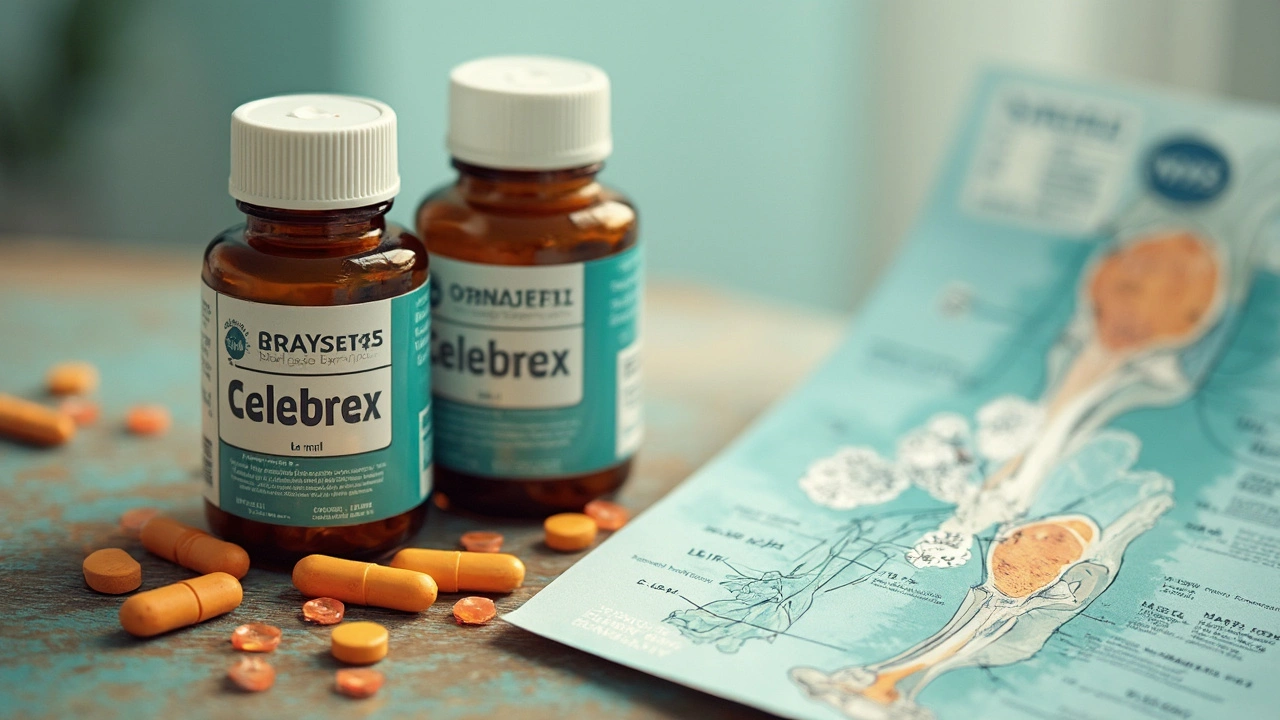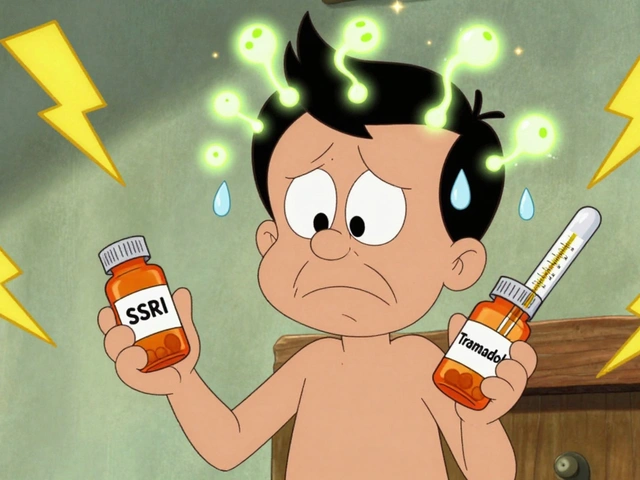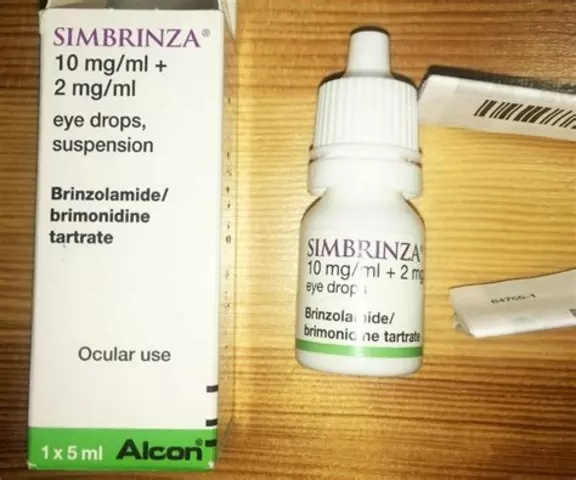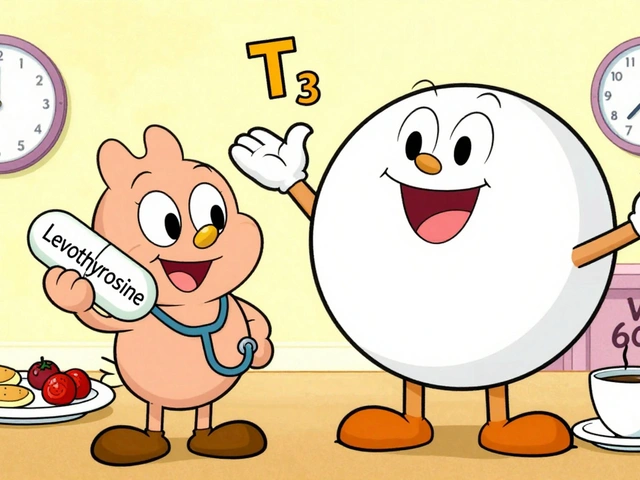Drugs that promise to make the ache go away—they get all the hype. But it's rare for any one pill to hold up under a microscope, especially when the pain keeps coming back every day. That’s where Celebrex (celecoxib) makes its entrance, a bit like that reliable friend who never shows up empty-handed. It’s not flashy, but it’s been around long enough to earn both fans and critics. If you, like a lot of people, wince every time your knees have to handle one flight of stairs, or you're waking up stiff and sore, you probably know someone who's been offered Celebrex. What does it really do, and is it better or different than popping something over-the-counter like ibuprofen?
How Celebrex Works: Science and Curiosity
Most folks get introduced to Celebrex through the word "arthritis.” But arthritis isn’t just for grandparents; younger adults and even athletes end up here, too. Celebrex is a non-steroidal anti-inflammatory drug, or NSAID, but with a twist. It targets a specific enzyme in your body called COX-2 (cyclooxygenase-2). Here’s why that matters: COX-2 is behind pain and inflammation when you have conditions like osteoarthritis, rheumatoid arthritis, or even a gnarly back injury.
You’ve heard of other NSAIDs: ibuprofen, naproxen, maybe even aspirin. Those shut down both COX-1 and COX-2 enzymes. COX-1 does helpful stuff, like protecting your stomach lining and keeping your kidneys happy. When regular NSAIDs block COX-1, you end up with side effects like stomach pain, bleeding, and sometimes ulcers. Celebrex dodges a lot of that—by aiming mostly at COX-2, leaving COX-1 mostly alone.
This difference gets tiresome in advertising, but the science is real: in big studies, patients on Celebrex were less likely to report serious stomach problems than those on older NSAIDs. A 2016 trial involving over 24,000 arthritis patients (PRECISION trial, if you want to Google it) found Celebrex stacked up well, offering similar heart safety and fewer stomach issues compared to ibuprofen or naproxen. It's not perfect, but it offers real value, especially for people who can’t handle regular NSAIDs anymore.
People use Celebrex for more than just arthritis. Doctors prescribe it for acute pain (like after surgery or dental work), period cramps, and certain rare genetic disorders. It’s usually sold as capsules: 100mg and 200mg are most common. How much you take depends on why you need it and how well your liver and kidneys are working. Your doctor sets the dose after reviewing your health history like a detective piecing together a crime scene.
But Celebrex isn’t magic. You need time for the medication to build up in your system—usually a few days for chronic pain relief, though sometimes the first dose knocks down bad pain quickly. People sometimes feel tempted to double up when they don’t get fast relief, but that’s asking for trouble (think: higher odds of side effects).
Pain and swelling don’t always listen to medication, especially in stubborn arthritis cases. You may need to pair Celebrex with physical therapy, changes in activity, or even other meds. Some people get real relief—others, not so much. If you’re like Fiona, my wife, you know the drill: she needs prescription-level pain control for a few rough days each month, and over-the-counter stuff just didn’t cut it. Her rheumatologist switched her to Celebrex last year, and it literally made the difference between being able to walk the dog or spending the afternoon on the couch.
It’s a reminder that one size never fits all with medication. Ask questions, take notes on how you feel, and let your provider know if things aren’t working. Sometimes it takes a while to dial in the right pill and dose, but when you’re limping through the day, even small improvements feel huge.

Side Effects and Safety: What You Should Really Watch Out For
Everyone wants the upside of pain relief, but nobody signs up for side effects. Celebrex, like all prescription drugs, has some asterisks next to its promises. Here’s the honest lay of the land.
The classic NSAID side effects are stomach pain, heartburn, nausea, and (in rare cases) ulcers and GI bleeding. With Celebrex, those are less likely, but not wiped out completely. You can still end up with an upset stomach, especially if you have a history of gastric problems, or mix it up with booze or certain other meds.
What else can happen? The FDA requires a black box warning—the strictest type—about the possibility of increased heart attack and stroke risk, especially if you have pre-existing heart disease or take the drug for long periods. And to be clear: all NSAIDs carry this risk, not just Celebrex. Scientists still argue about exactly how risky it is, but if you have high blood pressure, high cholesterol, or a history of cardiac events, you need a careful conversation before starting this med. It’s not a no-go for everyone with heart risks, but it’s not something to ignore either.
Here is a quick table comparing the rates of some important side effects from a few big studies:
| Side Effect | Ibuprofen | Naproxen | Celebrex |
|---|---|---|---|
| Stomach Ulcers | 2.5% | 3.5% | 1.5% |
| Heart Attack | ~0.4% | ~0.4% | ~0.4% |
| Stroke | ~0.3% | ~0.3% | ~0.3% |
If you look at the numbers, Celebrex is a little gentler on the belly, but not miraculous. It doesn’t “cause” heart attacks, but it might raise the risk in people who already have heart or blood vessel problems. If you’re healthy otherwise, the risk is pretty tiny.
Other possible side effects include headache, dizziness, swelling in the legs or feet (that one gets old fast), and allergic reactions—sometimes severe. Sulfa allergies are a red flag because Celebrex has a sulfonamide group in its chemical structure. If you’ve had a bad reaction to sulfa drugs, your doctor will usually steer you somewhere else.
Your doctor will probably run liver and kidney tests before and during your Celebrex script, especially if you’re older or have other health issues. Because it can mess with kidney function, you’ll want to watch for anything weird like a sudden gain in weight, lots of swelling, or changes in urination.
So what can you do to stay safe? Here are some tips:
- Take Celebrex with food or milk to lower stomach irritation.
- Try not to mix it with other NSAIDs or aspirin unless your doctor gives the green light.
- Limit alcohol and avoid smoking—they both up the risk of GI side effects and heart problems.
- If you notice chest pain, shortness of breath, weakness on one side, or trouble speaking, get help fast. These could be signs of serious problems.
- Let all your health care folks know you’re on Celebrex, including dentists and pharmacists. Some drugs and procedures interact badly.
The absolute key? Listen to your body—nobody knows your "normal" like you. The best “medicine” is usually a mix: movement, stretching, smart food choices, enough water, and managing stress along with medication. Celebrex is a tool, but not a life hack.

Getting the Most from Celebrex: Practical Tips and Personal Insights
If you're trying out Celebrex or thinking about it, making a few small changes can really smooth out the bumps. First up, timing. Celebrex kicks in around 1-2 hours after you take a dose, but the biggest help comes when you take it steadily. Don’t skip days or stop abruptly unless your doctor says so. If you miss a dose, take it as soon as you remember, unless it's almost time for the next one. Doubling up rarely helps and risks more side effects than relief.
I've found it helps to tie taking my meds to something routine—like brushing your teeth or eating breakfast. Hard to forget that way. Some folks find making a chart or using a reminder on their phones is a huge help, especially when juggling multiple meds.
Pair Celebrex with movement, even if you don’t feel like it. I know—sounds cruel when you’re hurting, right? But gentle activity keeps joints healthier and helps the drug work better. If I sit too long on weekends, my old sports injuries flare up way worse, even if I’ve dosed up. Walking the dog or hitting the pool makes a bigger difference than you'd expect.
Talk to your provider about your diet. Foods high in omega-3s, for example, might help reduce inflammation a bit. On the flip side, lots of processed snacks and alcohol can worsen swelling and slow down healing. My own sweet tooth can cause trouble if I’m not paying attention—I learned the hard way that sugar overload triggers my joint pain. Small swaps build up over time.
Manage expectations. Celebrex isn’t a miracle; it’s more like a reliable background player. For many, it takes the edge off—the difference between making it through a workday or calling in sick, not necessarily wiping out pain 100%. Sometimes, it stops working as well and you need to switch to something else, or add therapies like heat, massage, or different medications for breakthrough pain.
Keep your doctor in the loop about any changes—good or bad. Side effects? Note them. A new ache or weird swelling? Say something. Tracking your symptoms with a simple pain diary can actually help spot patterns and avoid bigger headaches down the line.
Some things to avoid: don’t mix Celebrex with other NSAIDs unless told to, as this can really up the risk for problems. Avoid herbal remedies or supplements without checking—some can boost side effect risks, especially if they thin the blood or strain the liver.
Remember, cheaper isn’t always better with pain meds. Generic celecoxib is typically just as effective as the brand-name stuff, so cost shouldn’t keep you from getting relief if you need it. Most insurance plans cover celecoxib; if not, ask about discounts or generic options.
One final real-world tip? Respect the cues your body sends. Days when Fiona feels worn out or swollen, she’ll scale back on tough workouts and take extra time to rest—even if the calendar is packed. Celebrex helps her do this without feeling totally defeated, and that’s worth a lot. Chronic pain is unpredictable, but being mindful makes a real difference day to day.

 How to Comfort a Bird After Deplumation - Step‑by‑Step Guide
How to Comfort a Bird After Deplumation - Step‑by‑Step Guide
 SSRIs and Opioids: Understanding Serotonin Syndrome Risk and How to Prevent It
SSRIs and Opioids: Understanding Serotonin Syndrome Risk and How to Prevent It
 Exploring the Top 8 Alternatives to Canadapharmacy.com in 2025: Navigating the Online Pharmacy Landscape
Exploring the Top 8 Alternatives to Canadapharmacy.com in 2025: Navigating the Online Pharmacy Landscape
 Tips for ensuring proper hygiene while using brimonidine tartrate eye drops
Tips for ensuring proper hygiene while using brimonidine tartrate eye drops
 Thyroid Medications: Levothyroxine Safety and Monitoring
Thyroid Medications: Levothyroxine Safety and Monitoring
Kim and Lin
July 18, 2025 AT 02:26I've been on Celebrex for a bit now due to my arthritis, and honestly, it’s been a game-changer. The article does a great job breaking down the basics, but I’d add that managing side effects is key. Personally, I had to monitor my stomach closely since NSAIDs can be harsh there.
Also, anyone starting this medication should definitely keep close communication with their doctor. It’s not a one-size-fits-all, and adjustments might be necessary depending on how your body reacts. Has anyone here experienced issues with the cardiovascular warnings Celebrex sometimes gets?
It'd be great to discuss personal tips for navigating those concerns safely. Sharing experiences could really help others feel less overwhelmed when starting treatment :)
Kemari Nielson
July 18, 2025 AT 03:26Thanks for the detailed post. A precise understanding of Celebrex’s mechanism is essential for safe usage. It selectively inhibits the COX-2 enzyme, which is why it usually has fewer gastrointestinal side effects compared to traditional NSAIDs. However, patients must be vigilant about heart health, as increased cardiovascular risk is documented in several studies.
It would be prudent for anyone considering Celebrex to discuss their full medical history, especially if they have any preexisting heart conditions. The article’s advice on following medical guidance and watching for side effects is spot on.
Steve Helsel
July 18, 2025 AT 04:26Honestly, I’m a bit skeptical of the hype around Celebrex. Sure, it’s prescribed a lot, but it’s not a miracle drug. If you read the fine print and clinical reviews, the benefits might be quite marginal in many cases, especially when balanced against the risks.
People should be careful not to use it as a crutch without exploring other lifestyle changes or physical therapies. Medication should complement, not replace, holistic approaches to arthritis management.
Anyone else here tried alternative therapies alongside Celebrex?
Steve Moody
July 18, 2025 AT 05:26Precisely articulated, indeed! Celebrex's selective inhibition of COX-2, as Kemari correctly noted, dramatically limits the notorious gastrointestinal complaints typical of non-selective NSAIDs. Nevertheless — one must not overlook the nuanced cardiovascular implications that lurk beneath the seemingly benign profile.
This medication may well represent significant progress in analgesic pharmacology but let's not be hasty to elevate it to panacea status without due consideration of the randomized control trials evidencing its pitfalls.
The article serves as an introductory beacon — yet readers should strive for comprehensive understanding by consulting peer-reviewed sources and medical experts.
Adrian Hernandez
July 18, 2025 AT 06:26I'm telling you, all these so-called 'safe' drugs like Celebrex are just part of a huge pharma conspiracy. They keep pushing these meds while masking real side effects and long-term damage. The cardiovascular warnings? That’s the tip of the iceberg they don’t want you to know about.
They make it seem like you’re the problem if you have issues, not the meds themselves. People need to wake up and question these standard treatments instead of blindly obeying prescriptions.
Anyone else feeling suspicious about the safety claims surrounding Celebrex?
duncan hines
July 18, 2025 AT 07:26Honestly, I used Celebrex once and it was a total disaster for me. I started feeling all sorts of random aches after a week🤦♂️. Thought it was supposed to help my joints but seemed like it was creating new problems instead. The side effect profile in these writeups always sounds way too optimistic.
And what's with all these warnings about heart problems? Makes me think twice about even considering it again. People need to be warned more aggressively about the potential dangers.
Mina Berens
July 18, 2025 AT 08:26It's really so important to weigh the pros and cons when considering Celebrex 🤔. From my observations and those shared by friends, it effectively eases inflammation and pain, but it’s not magic — side effects happen.
One cool tip: taking it with food often helps reduce stomach discomfort. Also, keeping a symptom diary helped me notice what timings or dosages worked best.
Remember that your body's response can be unique, so patience and communication with your healthcare provider are key. Anyone have tips for managing stiffness alongside Celebrex use? 🌟
Chris Meredith
July 18, 2025 AT 09:26From a pharmacological standpoint, celecoxib's preferential targeting of COX-2 isoenzyme epitomizes selective enzyme inhibition, reducing prostaglandin synthesis responsible for pain and inflammation. This selectivity ostensibly mitigates gastrointestinal ulcerations prevalent in non-selective NSAIDs administration.
However - albeit rare - the cardiovascular risks, presumably due to prostacyclin-thromboxane imbalance, necessitate judicious prescription, particularly in patients with preexisting risk factors.
In clinical practice, it is imperative to combine pharmacodynamics understanding with patient-centric evaluations for optimal therapeutic outcomes.
Jessie Eerens
July 18, 2025 AT 10:26This thread highlights the ongoing dialectic concerning Celebrex's role in modern arthritis management — fascinating!
One must consider how the molecular modality of celecoxib, a COX-2 selective inhibitor, juxtaposes with traditional NSAIDs. The pharmacological elegance here is tempered by complex risk-benefit analyses.
Indeed, the conversation must expand beyond pain relief to encompass long-term implications, patient adherence, and clinical monitoring. As always, an informed patient is an empowered patient!
Caroline Lane
July 18, 2025 AT 11:26I get it, Celebrex works for some, but I can’t ignore how many people suffer side effects that are downplayed.
It’s super frustrating because sometimes doctors just shove these meds at you without enough explanation, like, “Here, this will fix your pain,” but they don’t mention the scary cardiac risks or how your body might react differently. We deserve full transparency, not this sugar-coated nonsense.
I hope more people ask the hard questions and push for alternatives when they feel uncomfortable. Don’t let anyone silence the real concerns!
Geneva Lyra
July 18, 2025 AT 12:26Thanks for outlining the essential information about Celebrex in this post! It’s so important we have clear, accessible education on medications used for chronic conditions, especially arthritis, which affects so many diverse communities.
I’d encourage everyone to consider complementary approaches too, like diet and gentle exercise, alongside medical treatment. Cultural perspectives on managing pain can also bring valuable insights.
Feel free to share any personal stories or questions — this is a safe space to learn and support each other!